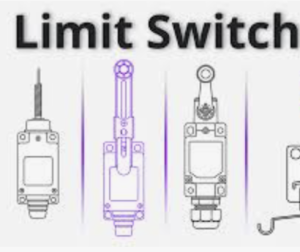
1. Introduction
Limit switches are fundamental components in industrial automation and machinery control. These electromechanical devices detect the presence, absence, or position of objects, enabling precise control over machinery movement and enhancing safety. This article explores their design, functionality, applications, and selection criteria.
2. What is a Limit Switch?
A limit switch is an electromechanical device that converts mechanical motion into an electrical signal. It consists of an actuator linked to electrical contacts, which open or close when the actuator is displaced by an object. This action controls circuits to start, stop, or alter operations in systems like conveyor belts, elevators, or robotic arms.
3. Key Components
Actuator: The physical component (e.g., lever, roller, or plunger) that interacts with the target object.
Contacts: Electrical terminals that open (break) or close (make) the circuit. Configurations include Normally Open (NO) and Normally Closed (NC).
Housing: Protects internal components from environmental factors (dust, moisture).
Terminals: Connection points for wiring.
4. Types of Limit Switches
By Actuator Design:
Lever Arm: A pivoting arm for bidirectional detection (common in conveyor systems).
Roller Plunger: A spring-loaded plunger with a roller tip for linear motion.
Spring Rod: Flexible rod for high-speed or vibrating environments.
Rotary Actuator: For rotational movement detection.
By Contact Operation:
Momentary: Contacts return to default state after actuation.
Maintained: Contacts remain in the actuated state until reset.
5. Working Principle
When an object contacts the actuator, it triggers a mechanical movement, altering the contact state:
NO Contacts: Close to complete the circuit.
NC Contacts: Open to interrupt the circuit.
This change signals controllers (PLCs, relays) to execute actions like stopping a motor or reversing direction.
6. Applications
Industrial Automation: Position control in CNC machines, robotic arms.
Safety Systems: Over-travel prevention in elevators or garage doors.
Material Handling: Detecting objects on conveyors.
Agriculture: Monitoring equipment like tractors or harvesters.
7. Specifications and Selection Criteria
Electrical Ratings: Voltage (12V–480V) and current (1A–15A) capacity.
Mechanical Life: Cycles (1 million+ for heavy-duty models).
Environmental Protection: IP67 (dust/water resistance) or NEMA 4X (corrosion-proof).
Actuation Force: Force required to trigger the switch (e.g., 0.5N–50N).
Selection Tips:
Choose stainless steel housing for corrosive environments.
Opt for roller actuators in high-speed applications.
8. Installation and Maintenance
Mounting: Secure alignment with the target’s path.
Wiring: Follow NEC/IEC standards; use shielded cables in noisy environments.
Maintenance: Regularly inspect for wear, clean contacts, and test continuity.
9. Advantages and Disadvantages
Pros:
Rugged, reliable in harsh conditions.
Simple installation and low cost.
Cons:
Mechanical wear over time.
Slower response vs. solid-state sensors.
Comparison with Proximity Sensors:
Limit switches excel in dusty/grime-heavy settings but lack non-contact sensing.
10. Troubleshooting Common Issues
Failure to Actuate: Check for misalignment or broken springs.
Electrical Noise: Ensure proper grounding.
Contact Arcing: Replace contacts if pitted or corroded.
11. Safety Standards
UL 508: Industrial control equipment certification.
IEC 60947-5-1: Global standard for circuit performance.
NEMA Ratings: Enclosure durability (e.g., NEMA 4X for outdoor use).
12. Innovations
Wireless Limit Switches: IoT integration for remote monitoring.
High-Precision Models: Laser-adjusted actuators for micron-level accuracy.
Sealed Designs: Enhanced IP69K ratings for extreme environments.
13. Conclusion
Limit switches remain vital for safe and efficient machinery operation. Understanding their types, applications, and maintenance ensures optimal performance in diverse industrial settings. As technology evolves, integration with smart systems will further expand their capabilities.
- Everything You Need To Know About Limit Switch - May 21, 2025
- Everthing You Should Know About Rheostat - May 20, 2025
- Everything You Need To Know About Reversing Contactor - May 19, 2025






